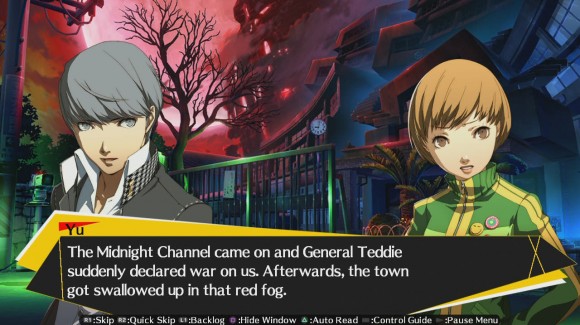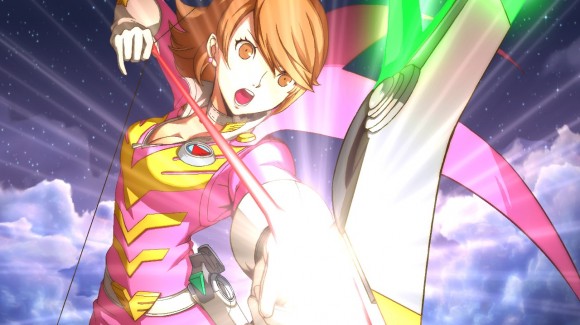When Persona 4 Arena was released it was easy to dismiss the game as a cheap cash in. After all, a fighting game based on a well known RPG series could only exist to line some coffers, right? I eventually picked up the game on a sale and was pleased to discover how wrong I was. The game had a system that was easy to pick up but difficult to master, great presentation, and a robust story mode that continued the stories of Persona 3 and 4 with obvious care and fondness for the characters and an emphasis in consistency. When I heard that a sequel was coming out, I had to pick it up. Persona 4 Arena Ultimax has everything one could expect from the sequel of a fighting game; new characters, new modes, a new story mode, and it still manages to keep the design philosophy that made the first game great.
Persona 4 Arena Ultimax picks up right where the last game left off. The day after the events of the last game, the Investigation Team (Persona 4’s main characters) are trying to make sense of the events that took place in Persona 4 Arena. They go home thinking everything is resolved, when the Midnight Channel comes on to announce a new tournament, and as an incentive shows the members of the Shadow Operatives (Persona 3’s group) captive in crosses. As the broadcast ends, the town fills with a foreboding red fog and the cast sets off for another adventure. The story is a direct continuation of the last game, which itself is a sequel of sorts for Persona 3 and 4. The game clearly expects you to have played all these games, and be familiar with the plot. The game does take some time to explain who the main players are, and establish some of the concepts, but for the most part the game values the pace of its story over exposition. The game does have the original story mode available as DLC for $5, but even then there are references to the RPG’s that are important to the plot and not explained. In short, if you haven’t played Persona for awhile, this probably isn’t a good starting place.
The story mode itself has been revamped. Instead of having a play-through for each character, the game is divided between different episodes. You will first see the story from the point of view of the Persona 4 characters, once that is cleared you will open up additional episodes that will show the story from different points of view. It does make the story mode flow better, but since it forces you to fight with specific characters in each chapters, you will not get to spend as much as you’d probably like with your favorite characters. It is pretty easy, though and a good way to learn the different fighters and their style.
Persona 4 Arena Ultimax understands that its audience may not be die-hard fighting game fans, and so its combat focuses heavily on a system of automatic combos that’s very easy to pick up and makes one feel competitive immediately. That’s not to say that the system doesn’t have some depth, there are plenty of extra moves, combos and reversals for players to master. Diligent players can potentially have a huge advantage if they are willing to spend the time. Accessibility is good, but overall the game feels a little too easy, even in the harder difficulties. Players looking for a challenging fighting would be better served elsewhere. I feel that the auto combo system is a double edge sword as well. While it does make it easy for players to pick the game up and play, it also makes it so players do not experiment with other combinations. Many of the players I met online tried to spam the auto combos, and had little in the way of creativity when that didn’t work.
Speaking of which, the online matchmaking works well but only for ranked matches. If you are interested in fighting just for fun, the game offers a lobby system. This makes it annoying because you have to wait until your turn, which can be a long time in the larger rooms. You are also at the mercy of the owners of said rooms, who can kick you for any reason from not liking your connection speed, to just because they forgot to set the room to private. Still it is a good place to go test your skills once you have finished the story mode and are done with the small challenge the AI presents. Since the game presents not only a standard version of most fighters, but also a “shadow” version, which has a few different moves and different powers, there is plenty of variety in the characters to master.
The game also has a plethora of things to unlock, including music, art, and custom titles and icons for online play, so there is an incentive to keep playing it after you have finished it. These things can be unlocked by finishing the arcade mode, completing challenges, or my favorite method: playing the dungeon mode. In this mode you are tasked with clearing dungeons, which are really a series of encounters using a single health bar. You recover some health between matches, but not much. As you progress your chosen character levels up, earning stat increases and techniques. Techniques are buffs that help you during battle, from inflicting status effects under specific circumstances, to increasing your character’s strength and speed. Dungeon mode can be challenging, and it forces you to think a bit more about how you use your character, since relying in the gun-ho style required by the auto-combo system will ensure you don’t last long.
Persona 4 Arena Ultimax is a great game to pick up for any fan of the Persona franchise, even if they do not own the original. It is a worthy close to the stories of the two PS2 era JRPG’s, and it is always interesting to see how the characters changed from their time in the game. This is especially true of the Persona 3 characters who have had a good amount of time pass between the games. If you are looking for an easy fighting game to pick up and play with friends and have fun then this is perfect. More serious fighting game fans who are looking for a challenge may want to look elsewhere.









